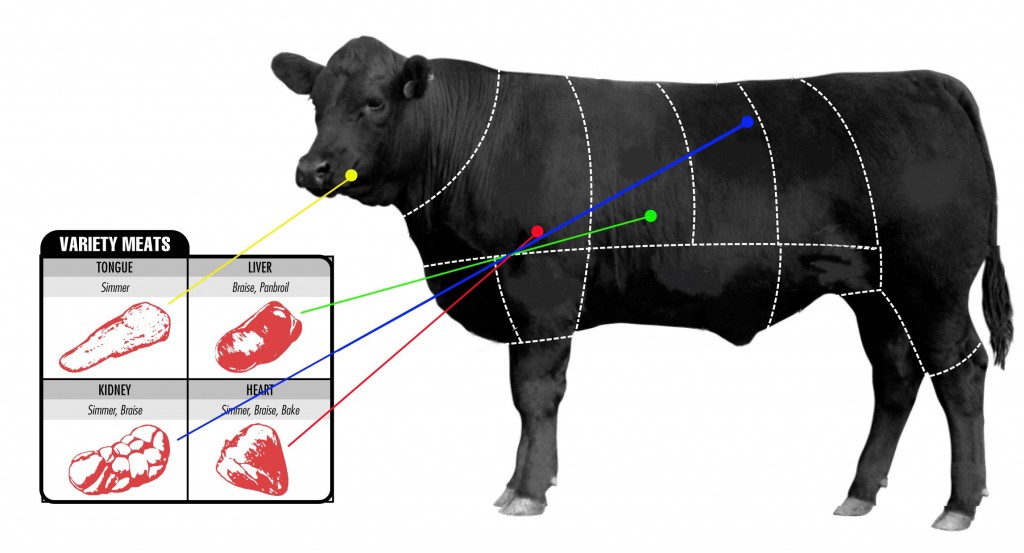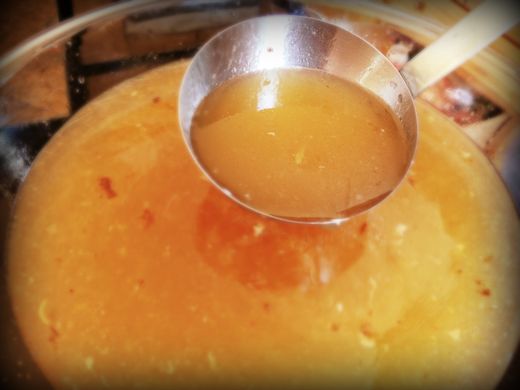
© Primal Docs
Organ meats were a staple part of our ancestors diets and provided a tremendous nutritional benefit to groups of people who had limited access to other nutrient dense
foods. Our current society has no emphasis on organ meats and they are mostly avoided. Consuming organ meats on a regular basis can provide one with incredible health and performance benefits.
Our ancestors experienced times of feast and famine and had to make the most out of each calorie source they had access too. When they killed an animal they would consume every part of the animal. The native Americans and other tribal groups and the original healers believed that eating the organs from a healthy animal would improve the health of the organs of the individual.
Here are some organ meats that you may benefit from including in your diet. These should all be from organic, grass-fed or pasture-raised animals and not ever from industrial farm raised animals. I like to get mine from my local farmer and also from
US Wellness Meats which ships all over the country. Be sure to check out my sources at the end of this article for many great websites that have articles and recipes for how to use different organ meats. Here is a great
article from Amanda at the Curious Coconut.

© Primal Docs
This is actually more of a muscle than an organ but it does contain a high percentage of calories from fat. Most tongue is about 70% fatty acids, making it one of the most tender cuts of beef. Most people really enjoy the flavor of tongue more than ground beef and steaks. It is also easy to prepare and can be used in a variety of different recipes.
HeartHeart doesn't look very edible but most are quite surprised to know that it tastes good! Many have compared its taste and texture to that of steak or brisket. This is a great source of iron, zinc, selenium, B vitamins such as B2, B6, Folate and B12. The heart is especially rich in CoQ10 which is vital for mitochondrial health and energy production.
Most people with chronic health conditions are deficient in CoQ10 and have mitochondrial damage. Heart is the best overall food source of CoQ10. Bison, buffalo, venison and beef heart are the richest sources of this powerful nutrient. Heart does not have a lot of fat and is quite lean and muscular. Many enjoy it ground down and added to a ground beef mix.
LiverLiver is by far the most nutrient dense organ meat to consume. It is perhaps the most nutrient dense food on the planet and contains specific bioavailable forms of nutrient complexes that are very challenging to get elsewhere.

© Urbancooking.net
Liver is a powerful source of pre-formed vitamin A, also called retinol. Three ounces of beef liver is estimated to contain about 26,973 IU of vitamin A, chicken liver contain roughly 15,306 IU. Cod liver oil is another powerful source of retinol but eating liver on a biweekly basis can provide the amount you need for optimal health.
Liver is very rich in bioavailable folate, choline and B12 which are nutrients necessary for a number of major functions in the body. Many individuals who are following a healthy lifestyle opt for a
diet rich in sustainably raised, organic muscle meat. While this meat has its benefits it is also quite high in methionine. Elevated methionine increases homocysteine production. A few of the key nutrients needed to reduce homocysteine levels include folate, choline and B12.
Liver is the richest source of B12 with roughly three times as much as kidney, seven times more than heart and 17 times as much as tongue or ground beef. Liver is also rich in nutrients such as selenium, iron and
zinc that are critical for healthy function.
Most people don't have much of a taste for liver and some downright hate it. I recommend cooking it in a stew or mixing it into ground beef at an 80/20 (80% ground beef and 20% ground liver) and most never even notice. This is the best way to get it into your children's diet as they will not even tell the difference if you use this ratio and make naked beef burgers. Here is a great
article from "Thank Your Body."
Kidney
© TastyBits.com
This is also highly nutrient dense and very concentrated form of protein with the full array of amino acids. The most available kidneys are from beef and lamb. If you purchase a whole chicken or turkey, you will obviously have the kidneys inside as well.
You ideally want to get them with the long strip of fat still in the center. If this is from grass-fed
beef or lamb that fat has a good amount of both saturated and omega 3 fatty acids. This is extremely healthy and anti-inflammatory. Most say that beef kidney is the most mild in flavor and is one of the best to start with.
For a milder taste, try soaking in chilled water with a teaspoon of pink salt for each quart of water. Let them sit for two hours and then boil, sauté or braise the kidneys and serve.
SweetBreads & SpleenThis refers to the thymus and the pancreas. These glands are pinkish-white in color and they taste sweeter than the savory taste that most meat has. The "bread" terminology comes from the old English word that means "flesh." These are considered delicacies in many South American and European countries.
The pancreas is the most sought after and the best tasting of the three. These glands are rich in trace minerals such as zinc and selenium which are key for hormonal function and immunity. They are rich in protein and omega 3 fatty acids that help reduce inflammation in the body. It is not a stretch to say that eating thymus & spleen will improve immunity and pancreas will improve digestive processes and blood sugar signaling.
Check out this great
recipe on Pure Life Natural.
BrainThe brain is by far the richest source of omega-3 fatty acids EPA and DHA. One four ounce portion of brain contains about a gram of EPA and a gram of DHA. This is equivalent to about a $5 serving of fish or krill oil. Brain also contains some powerful neurological enhancing nutrients such as phosphatidylcholine and phosphatidylserine.
Brain is also rich in anti-oxidants such as carnosine, carotenoids and tocopherols which protect neurological tissue from oxidative stress. It is also extremely rich in cholesterol which is another protective anti-oxidant for neurological tissue and helps to optimize hormonal function.
You can order beef brains or eat fish heads to get these valuable nutrients. Eyes are also extremely rich in retinol, the bioavailable form of vitamin A and other powerful anti-oxidants. Eating fish heads is revered for improving life vision and wisdom in many cultures and the nutritional benefits do improve the ability to think sharper and deeper.
Tripe & IntestinesTripe is the common term used to refer to the stomach lining of sheep, goats, beef and deer. This dish was so revered in European culture that it spurred a tiff between William the Conqueror and Phillip I, the King of France. This is a great source of micronutrients, gelatin and probiotics. Many have reported that eating tripe has greatly improved their digestive system.
Intestines are a profound source of gelatin and glutamine which are key for stabilizing and improving leaky gut function. The key for eating intestine and tripe is to cook it down real good as it is very rubbery. So putting into a bone broth stew is a great approach and as you are cooking down the bones the gelatin molecules are becoming less compact. This makes the raw nutrients more edible.

© Primal Docs

© Kayla Grossman
Not enough can be said about the nutritional benefits of consuming the nutrients in stock bones, ligaments, tendons and discs. The best way to consume these is by boiling the nutrients out in a crock pot over a 24 - 48 hour period depending upon the temperature and the strength of the collagenous structures. Most should scrape off into the pot within a day.
Bone broth can be made from any animal with bones and the most popular soup bones include those of fish, chicken, turkey, beef, lamb and venison. The bones house a variety of powerful nutrients that become released when they are slowly simmered in water for a few hours. These nutrients include bone marrow which helps provide the raw materials for healthy blood cells and immune development.
Bone broth provides the nutritional synergy to calm an overactive immune
system while supplying the body with raw materials to rebuild stronger and healthier cells. This is why it is such a great healing food to have when the body is encountering stress from bacterial or viral infections as well as digestive disorders and leaky gut syndrome.
Here is an awesome
recipe for homemade bone broth from Trisha from "Eat Your Beets."
Reader Comments
to our Newsletter